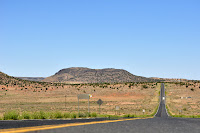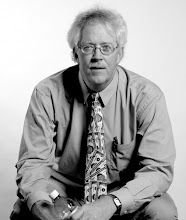Two groups left in the morning and stopped at Navajo Code Talker Keith Little's home for a third and final interview with Keith.
(Above three photos by Jessica King)
Keith enlightened the group more about his service to the United States during World War II and how he was treated-- and his work celebrated-- since his return home in 1945. Keith's wife, Nellie, spent quite a bit of time digging through photo albums to find pictures of Keith and his family over the years.
It was hard for your blog editor (a Minnesota Viking fan) to find out that Keith Little really likes the Green Bay Packers. This was a joyous moment for Robbie Christiano, a Packer fan since childhood.
The second group in this van did a third interview with Harold Morgan, legislative assistant to the Navajo Tribal Council. As that interview ended, Harold explained the significance of the bell mounted outside the Tribal Council chambers, and rang the bell for the students.
During a short break between interviews, the groups visited the Navajo Nation Museum and Zoo and shot some B-roll of important sites around the Window Rock, Arizona, area.
(Above three photos by Alex Fisher)
(photo by Molly Golden)
About dinner time, the groups stopped at Sawmill, Arizona, at Harold Morgan's place and interviewed Harold's Grandson, Michial, who spoke highly of his grandfather and the things he has learned from him.
This group stopped at a supermarket on the way back to the dorms at Diné College and bought some pizzas to make for dinner.
The two other student work teams left the Diné College campus at 7:15 a.m. and didn't return until after 9 p.m. They spent the day interviewing Mitzie Begay for a third time. As they finished their interviews and prepared to leave, Mitzie gave each of the student journalists gifts and the emotions were high in the room through lots of hugs.
The Navajo language doesn't have a word for "goodbye." Instead, most Diné people prefer to say "Hagoneé" which translates roughly to "until we meet again."
These two student groups also visited with Debbie Dennison, a local school superintendent, who knew Jack Jackson, Sr. (another of the featured elders) well. Along the way, they captured b-roll video of the schools where the featured Navajo elders went as children.
(Above two photos of road construction around the Diné College campus by Alex Fisher., These photos help tell the story of the construction funding secured by Jack Jackson, Sr., one of the featured elders for this year's Oral History project.)
(Above two photos by Alex Fisher)
(above six photos by Dave Dvorak)
The group creating a documentary about former Arizona Senator Jack Jackson, Sr., also interviewed his neice, Deborah Jackson-Dennison, a local school superintendent.
(above two photos by Dave Dvorak)
In the evening, they stopped at the home of Tina James Tafoya, a former Miss Navajo, who now works with Mitzie Begay at the Fort Defiance Indian Health Service Hospital.
NOTE: This second van that included the Jack Jackson, Sr. team and the Mitzie Begay team arrived back at Diné College and immediately started downloading their video, editing their audio and photographs and transcribing their interviews. No pictures from this group, yet. This article may be updated with more images.
Thursday will be a class day and catch-up day. In class, each group will explain the progress on their journalism projects and decide on any last details that must be completed before the Minnesota students leave the Navajo Nation next Tuesday. The rest of the day will be spent running around gathering B-roll and photos to supplement the projects.
It's amazing to Prof. Miranda Haskie and I to see how quickly these young people have bonded with their elders and their fellow students. They are united by the importance of their work and the desire to do an honorable job of telling the amazing stories of their elders.
These students are working hard, pouring their time and talent into these projects. They are learning much about the craft of journalistic story-telling, and even more about themselves as they discover their place in a world that includes the deeply spiritual culture of the Diné (Navajo) People.





























No comments:
Post a Comment